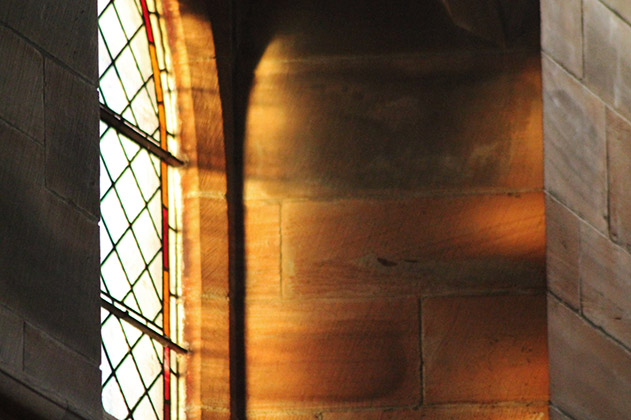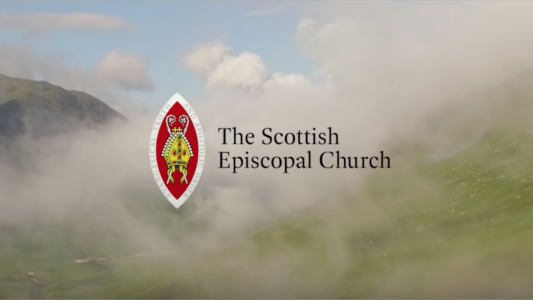Sunday | Weekdays | Advent | Christmas and Epiphany | Lent | Holy Week | Easter
Ordinary Time and the Feast of Christ the King | Other Feasts of the Lord | Saints Days
Sunday
Sunday is the principal day on which worship is offered in our Churches. The liturgies we celebrate recall that on this, the first day of the week, God began the work of creation transforming chaos and darkness.
Above all they recall that on this day Jesus rose from the dead ushering in a new age of justice and peace.
The principal service offered on a Sunday is the Holy Eucharist in which, through the taking, blessing, and sharing of bread and wine, the body and blood of Christ, we celebrate the saving acts of God, rejoice in the presence of the risen Christ amongst us, and look forward to the coming kingdom of God.
Other services offered in our Churches on a Sunday include services in celebration of the Word of God and services of Morning and Evening Prayer.
Weekdays
Although Sunday is the principal day on which worship is offered in our Churches, there is a tradition of daily worship in many of our Churches.
In most there will be a simple celebration of the Holy Eucharist at some point in the week.
In some the Eucharist will be celebrated every day. In others Morning and Evening Prayer will be offered.
Advent
The season of Advent, which begins on the fourth Sunday before Christmas and marks the beginning of the Liturgical Year, takes its name from the Latin “adventus” meaning “coming” or “arrival”.
During this season we look forward to the second coming of Jesus whilst at the same time preparing to celebrate his first coming.
This is a penitential season in which lives are re-examined as we reflect upon the world to come and upon the return of Jesus.
This penitential aspect is reflected in the music we sing, in the wearing of purple vestments, and in the absence of flowers in Church. But there is also great joy in this season as we anticipate Christmas and look forward to the promised day when war and violence will be no more.
In many of our Churches a wreath of five candles symbolising the Patriarchs,
the Prophets, John the Baptist, the Virgin Mary and the Christ Child is set up.
The candles are lit in turn on each of the four Sundays in Advent. The final candle is lit at Christmas.

Christmas and Epiphany
On the twenty-fifth of December we celebrate the birth of Jesus and the doctrine of the Incarnation.
Flowers return to Church along with other festive decorations such as crib scenes and Christmas trees. White or gold vestments symbolising joy are worn.
In many of our Churches, mindful that Jesus the light of the world was born at night, the first Eucharist of Christmas is celebrated as midnight strikes.
In addition to celebrations of the Holy Eucharist many of our Churches hold Carol Services and special services for children and young people at Christmas.
On the 6th of January (or the Sunday preceding it) we celebrate the Feast of the Epiphany. This recalls the visit to the infant Jesus by wise men from the East and the manifestation of Jesus to the nations of the world.
The name comes from the Greek “epiphaneia” meaning “manifestation”. This theme of manifestation is continued on the following Sunday when we celebrate the Baptism of Jesus by John the Baptist in the River Jordan.
In some of our Churches baptismal water is blessed on this day and baptismal promises are renewed.
Having celebrated the Baptism of the Lord we then turn our attention to Jerusalem and to the
passion, death and resurrection of Jesus.
Lent
Easter is preceded by a forty day period of penitence and fasting called Lent, after an old English word for spring.
Sundays in Lent are not included within this forty day fast (because Sundays are festivals of the resurrection of Jesus), and thus Lent begins six and half weeks before Easter on a Wednesday.
This day is called Ash Wednesday after the custom, still observed in many of our Churches, of receiving on this day on one’s forehead the mark of the cross in ash as a sign of penitence.
During Lent many people try to live more simply, foregoing some luxury they enjoy and giving the money they have saved to charity. Others take up new interests and tasks.
Mindful that this is, above all, a time for prayer and reflection many of our Churches hold weekly study groups during Lent to which all are welcome.
Flowers are again absent from Church during Lent and purple or unbleached white vestments symbolising penitence and simplicity are worn.
Holy Week
The week before Easter is called Holy Week. On the Sunday before Easter, Palm Sunday, we recall both the triumphal entry of Jesus into Jerusalem and his passion.
In many of our Churches the Liturgy begins with the blessing and distribution of palms which is followed by a procession through the local streets or around the Church. Later in the Liturgy the Passion Story is read or sung dramatically.
The Thursday before Easter is called Maundy Thursday from the Latin “mandatum novum” (“a new commandment”) after the Gospel reading for the day.
The evening celebration of the Eucharist may include a shared supper, the washing of worshippers’ feet following the example set by Jesus at the Last Supper, the taking of the sacrament to a place of reservation in preparation for the distribution of Holy Communion the following day, the stripping the Church of all its furnishings as Christ himself was stripped, and a prayerful watch for an hour or two in Church.
On Good Friday we remember the death of Jesus. In some of our Churches devotional services are held some lasting from midday to three o’ clock when Jesus hung upon the Cross.
In other Churches the Good Friday Liturgy is offered, during which the Passion Story is read or sung dramatically, prayers are offered for the Church, people of other faiths, and those in need, the cross is venerated, and Holy Communion received.
With the exception of Maundy Thursday, when white or gold vestments are worn, red vestments symbolising martyrdom are worn during Holy Week.
Easter
Easter, when we celebrate the resurrection of Jesus from the dead, is one of the oldest Christian festivals.
Following Jewish custom, the date of Easter is determined by the cycles of the moon and is always celebrated on the Sunday following the full moon occurring on or after the 21st of March.
In many of our Churches Easter begins with the celebration of the Easter Vigil either on the eve of Easter or at dawn on Easter Day.
During this historic service the Easter candle is blessed and lit, stories of liberation from the Old Testament are read, the resurrection is proclaimed, new Christians are baptised and baptismal promises renewed, and the Eucharist celebrated.
The season of Easter lasts for fifty days during which our Churches remain bedecked with flowers and white or gold vestments continue to be worn. Many Churches have Easter Gardens in which the hill of Calvary and the garden tomb are modelled in miniature.
On the fortieth day of Easter, a Thursday, we celebrate the Ascension of Jesus into heaven, rejoicing that our humanity, redeemed and transformed has been carried into the very presence of God.
On the fiftieth day of Easter, the Day of Pentecost, we celebrate the outpouring of the Holy Spirit upon the first disciples. On this final day of Easter red vestments, reminiscent of the tongues of fire which appeared to rest upon the heads of the Apostles, are worn.
The Sunday following the Day of Pentecost is called Trinity Sunday and on this day we celebrate God whom we believe to be Father, Son and Holy Spirit.
Ordinary Time and the Feast of Christ the King
The periods that follow the Baptism of the Lord and the Day of Pentecost are neither times of fasting or feasting and are thus referred to as “ordinary time”.
Green vestments, which take the colour of nature, are worn and the readings appointed for each Sunday lead us, in successive years, through the Gospels. These are times of stability in which, through the familiar offering of the liturgies of the Church, our faith grows and deepens.
The Liturgical Year ends with the celebration of the Feast of Christ the King on the Sunday before Advent.
On this day we give thanks for Jesus the servant king and look forward to that wonderful time when all the peoples of the world will be gathered together under his gentle and loving rule.
Other Feasts of the Lord
Throughout the year other events in the life of Jesus are also celebrated liturgically. Seven days after Christmas on the 1st of January we celebrate the naming of Jesus at the time of his circumcision.
Forty days after Christmas on the 2nd of February we celebrate the Presentation of the Lord by his parents in the temple in Jerusalem in fulfilment of the Jewish law.
Nine months before Christmas on the 25th of March we celebrate the Annunciation of the Lord to Mary by the angel Gabriel in her home in Nazareth.
On the 6th of August we celebrate the Transfiguration of the Lord before his closest disciples on the mountain, prior to his final journey to Jerusalem.
Mindful that Maundy Thursday, the day when we remember our Lord’s Last Supper, is also the day when we recall his betrayal, a separate feast in thanksgiving for Holy Communion, known as “Corpus Christi” (from the Latin for ”Body of Christ”) is held on the Thursday following Trinity Sunday.
Because Good Friday is likewise a sorrowful day, a separate feast in thanksgiving for the Holy Cross is also held on the 14th of September.
Saints Days
When we speak of the “liturgical year” we speak primarily of the great feasts of the Lord, of the seasons that accompany them and of the fasts that prepare for them.
But intermingled with this cycle of seasons, feasts and fasts, is the sanctoral cycle, the cycle of feasts of the Saints, through which we commemorate and draw inspiration from the heroes of our faith.
These men and women, whose lives we hold to be especially holy and inspirational, are usually commemorated on what is believed to be the dates of their deaths.
Some like the Apostles and those who brought the Christian faith to our land are celebrated by the whole Church. More local saints are celebrated according to custom and the wishes of the local community.
Mary the mother of Jesus has always had a special place in the hearts of Christians and is remembered in our Churches four times during the year.
Her principal feast is on the 15th of August but we also celebrate her conception on the 8th of December, her birth on the 8th of September and her visit to her relative Elizabeth, the mother of John the Baptist, on the 31st of May.
On the 1st of November, the Feast of All Saints, we remember saints known and unknown, not least those who have been a source of personal inspiration to us. On the following day, the Feast of all Souls, we remember the faithful departed.








